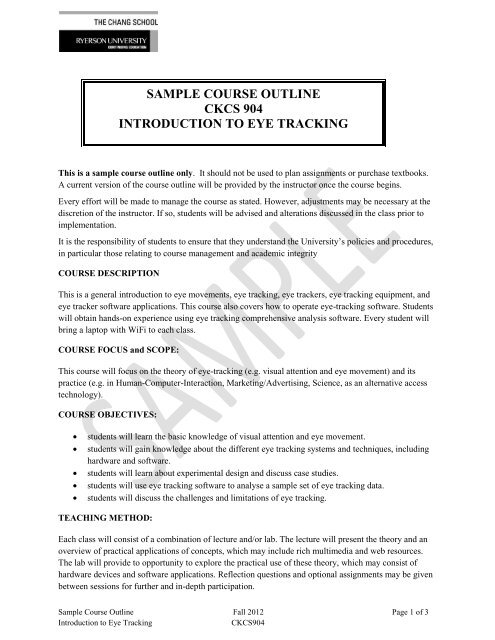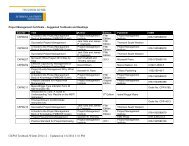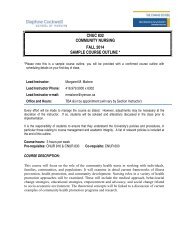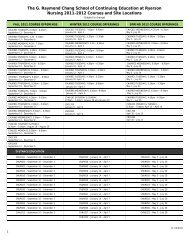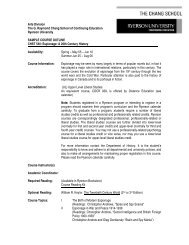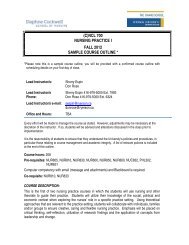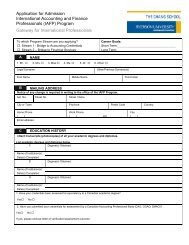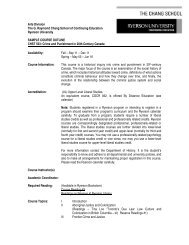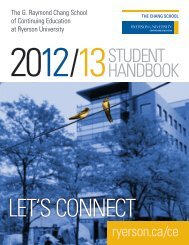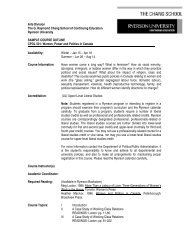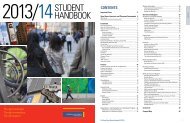Sample Classroom Course Outline - The Chang School - Ryerson ...
Sample Classroom Course Outline - The Chang School - Ryerson ...
Sample Classroom Course Outline - The Chang School - Ryerson ...
You also want an ePaper? Increase the reach of your titles
YUMPU automatically turns print PDFs into web optimized ePapers that Google loves.
SAMPLE COURSE OUTLINE<br />
CKCS 904<br />
INTRODUCTION TO EYE TRACKING<br />
This is a sample course outline only. It should not be used to plan assignments or purchase textbooks.<br />
A current version of the course outline will be provided by the instructor once the course begins.<br />
Every effort will be made to manage the course as stated. However, adjustments may be necessary at the<br />
discretion of the instructor. If so, students will be advised and alterations discussed in the class prior to<br />
implementation.<br />
It is the responsibility of students to ensure that they understand the University’s policies and procedures,<br />
in particular those relating to course management and academic integrity<br />
COURSE DESCRIPTION<br />
This is a general introduction to eye movements, eye tracking, eye trackers, eye tracking equipment, and<br />
eye tracker software applications. This course also covers how to operate eye-tracking software. Students<br />
will obtain hands-on experience using eye tracking comprehensive analysis software. Every student will<br />
bring a laptop with WiFi to each class.<br />
COURSE FOCUS and SCOPE:<br />
This course will focus on the theory of eye-tracking (e.g. visual attention and eye movement) and its<br />
practice (e.g. in Human-Computer-Interaction, Marketing/Advertising, Science, as an alternative access<br />
technology).<br />
COURSE OBJECTIVES:<br />
<br />
<br />
<br />
<br />
<br />
students will learn the basic knowledge of visual attention and eye movement.<br />
students will gain knowledge about the different eye tracking systems and techniques, including<br />
hardware and software.<br />
students will learn about experimental design and discuss case studies.<br />
students will use eye tracking software to analyse a sample set of eye tracking data.<br />
students will discuss the challenges and limitations of eye tracking.<br />
TEACHING METHOD:<br />
Each class will consist of a combination of lecture and/or lab. <strong>The</strong> lecture will present the theory and an<br />
overview of practical applications of concepts, which may include rich multimedia and web resources.<br />
<strong>The</strong> lab will provide to opportunity to explore the practical use of these theory, which may consist of<br />
hardware devices and software applications. Reflection questions and optional assignments may be given<br />
between sessions for further and in-depth participation.<br />
<strong>Sample</strong> <strong>Course</strong> <strong>Outline</strong> Fall 2012 Page 1 of 3<br />
Introduction to Eye Tracking<br />
CKCS904
SCHEDULE OF TOPICS:<br />
Week Topic<br />
WK 1 Human Visual System<br />
WK 2 Eye Tracking Systems<br />
WK 3 Eye Tracking Methodology<br />
WK 4 Eye Tracking Methodology<br />
WK 5 Eye Tracking Applications<br />
WK 6 Eye Tracking Applications<br />
Details<br />
Visual Attention, Eye Movements.<br />
<strong>The</strong> Eye and Retina<br />
Techniques, Hardware Devices and Software<br />
Applications<br />
Experimental Design, Guidelines<br />
Case Studies<br />
Human-Computer-Interaction,<br />
Human-Factors<br />
Marketing/Advertising, Science, Eye tracking<br />
as a control system<br />
WK 7 Review<br />
TEXTBOOK AND READING LISTS<br />
This is a sample course outline only. It should not be used to purchase textbooks. A current version<br />
of the course outline will be provided by the instructor once the course begins.<br />
Recommended Textbook:<br />
“Eye Tracking Methodology - <strong>The</strong>ory and Practice” (2007) 2 nd edition by Andrew Duchowski Softcover:<br />
ISBN 978-1-84628-608-7<br />
eBook: http://www.springerlink.com/content/978-1-84628-608-7<br />
EVALUATION:<br />
This is a non-credited course, and as such there are no formal evaluations or assignments.<br />
MISSED TERM WORK OR EXAMINATIONS<br />
Students are expected to complete all assignments, tests, and exams within the time frames and by the<br />
dates indicated in this outline. Exemption or deferral of an assignment, term test, or final examination is<br />
only permitted for a medical or personal emergency or due to religious observance. <strong>The</strong> instructor must<br />
be notified by e-mail prior to the due date or test/exam date, and the appropriate documentation must be<br />
submitted. For absence on medical grounds, an official student medical certificate, downloaded from the<br />
<strong>Ryerson</strong> website at http://www.ryerson.ca/senate/forms/medical.pdf or picked up from <strong>The</strong> <strong>Chang</strong><br />
<strong>School</strong> at Heaslip House, 297 Victoria St., Main Floor, must be provided. For absence due to religious<br />
observance, visit http://www.ryerson.ca/senate/forms/relobservforminstr.pdf to obtain and submit the<br />
required form.<br />
<strong>Sample</strong> <strong>Course</strong> <strong>Outline</strong> Fall 2012 Page 2 of 3<br />
Introduction to Eye Tracking<br />
CKCS904
PLAGIARISM<br />
<strong>The</strong> <strong>Ryerson</strong> Student Code of Academic Conduct defines plagiarism and the sanctions against students<br />
who plagiarize. All <strong>Chang</strong> <strong>School</strong> students are strongly encouraged to go to the academic integrity<br />
website at www.ryerson.ca/academicintegrity and complete the tutorial on plagiarism.<br />
ACADEMIC INTEGRITY<br />
<strong>Ryerson</strong> University and <strong>The</strong> <strong>Chang</strong> <strong>School</strong> are committed to the principles of academic integrity as<br />
outlined in the Student code of Academic conduct. Students are strongly encouraged to review the student<br />
guide to academic integrity, including penalties for misconduct, on the academic integrity website at<br />
www.ryerson.ca/academic integrity and the Student code of Academic conduct at<br />
www.ryerson.ca/senate/policies.<br />
RYERSON STUDENT EMAIL<br />
All students in full and part-time graduate and undergraduate degree programs and all continuing<br />
education students are required to activate and maintain their <strong>Ryerson</strong> online identity at<br />
www.ryerson.ca/accounts in order to regularly access <strong>Ryerson</strong>’s E-mail (Rmail), RAMSS, my.ryerson.ca<br />
portal and learning system, and other systems by which they will receive official University<br />
communications.<br />
COURSE REPEATS:<br />
Senate GPA policy prevents students from taking a course more than three times. For complete GPA<br />
policy see policy no. 46 at www.ryerson.ca/senate/policies.<br />
RYERSON ACADEMIC POLICIES<br />
For more information on <strong>Ryerson</strong>’s academic policies, visit the Senate website at www.ryerson.ca/senate.<br />
<strong>Course</strong> Management Policy No. 145<br />
Student Code of Academic Conduct No. 60<br />
Student Code of Non-Academic Conduct No. 61<br />
Examination Policy No. 135<br />
Policy on Grading, Promotion, and Academic Standing Policy No. 46<br />
Undergraduate Academic Consideration and Appeals Policy No. 134<br />
Accommodation of Student Religious Observance Obligations Policy No. 150<br />
Academic Accommodation of Students with Disabilities Policy No. 159<br />
<strong>Sample</strong> <strong>Course</strong> <strong>Outline</strong> Fall 2012 Page 3 of 3<br />
Introduction to Eye Tracking<br />
CKCS904


